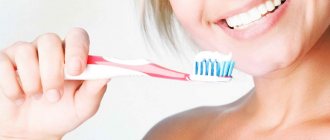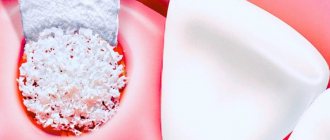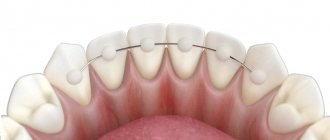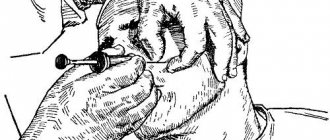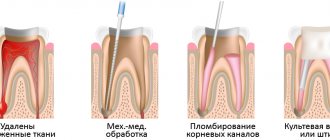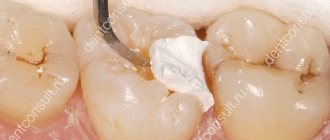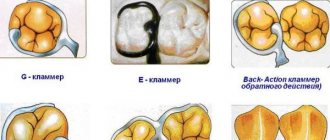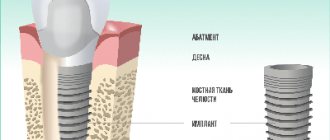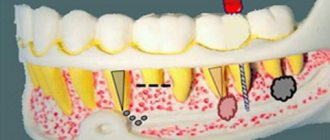When carrying out certain dental procedures, it may be necessary to reliably isolate the teeth from saliva, as well as the gums from the effects of chemicals used in treatment. For example, this is necessary when filling canals, restoring teeth and performing other complex procedures. Typically, special cotton or gauze swabs are used for these purposes. However, there is also such an alternative solution in dentistry as a rubber dam - a device that isolates the working surface from the mucous membrane during the treatment process.
Advantages and disadvantages of rubber dam
In dentistry, a rubber dam is a special rubber curtain that is installed on a tooth using clamps and isolates it from the surrounding oral cavity. This device is characterized by a whole list of indisputable advantages, among which the following are worth highlighting:
- reliable protection of the mucous membrane from the effects of chemicals;
- providing a good overview of the elements of the dentition;
- the ability to swallow during dental procedures;
- prevention of dry mouth;
- ensuring the most comfortable position of the tongue;
- eliminating the need to constantly change gauze swabs and rinse your mouth.
The use of rubber dam in dentistry significantly increases the degree of patient comfort during dental treatment. A person can breathe freely and swallow saliva, and the manifestations of the gag reflex are minimized. Patients note a decrease in fatigue of the masticatory muscles, which are usually in a tense state throughout the entire treatment process due to the need to keep the mouth open for a long time.
However, along with numerous advantages, the device in question also has a number of disadvantages, among which it is worth paying attention to:
- the possibility of developing an allergic reaction (silicone plates may be an alternative);
- possibility of injury to interdental papillae;
- the risk of losing axial landmarks when opening the entrance to the dental cavity;
- excessive requirements when conducting radiographic examinations.
If you have a problem similar to that described in this article, be sure to contact our specialists. Don't diagnose yourself!
Why you should call us now:
- We will answer all your questions in 3 minutes
- Free consultation
- The average work experience of doctors is 12 years
- Convenient location of clinics
Single contact phone number: +7
Make an appointment
Test with answers on the topic “Isolation of the working field: rubber dam in everyday use”
- home
- Tests
- Test with answers on the topic “Isolation of the working field: rubber dam in everyday use”
The pliers for applying clasps consist of a spring, a stopper and cheeks.
- for free
- Insulation
- use
- cofferdam
- medical
- nmo
- answers
- everyday
- fields
- worker
- topic
- Test
The pliers for applying clasps consist of a spring, a stopper and cheeks.
1. The gingival fluid is dominated by
1) B. melaninogenicus;+ 2) Str. mitis; 3) Str. mutans; 4) Str. salivarius.
2. The excretory duct of the parotid gland is located
1) on the submandibular papilla to the right and left of the frenulum of the tongue; 2) at the level of the second molar of the upper jaw from the vestibular side; 3) at the level of the first molar of the upper jaw from the vestibular side; + 4) at the level of the first molar of the upper jaw from the palatal side.
3. The excretory duct of the submandibular salivary gland is located
1) on the submandibular papilla to the right and left of the lingual frenulum; + 2) at the level of the second molar of the mandible on the lingual side; 3) at the level of the first molar of the upper jaw from the vestibular side; 4) at the level of the first molar of the upper jaw from the palatal side.
4. The excretory duct of the sublingual salivary gland is located
1) on the submandibular papilla to the right and left of the lingual frenulum; + 2) at the level of the second molar of the mandible on the lingual side; 3) at the level of the first molar of the upper jaw from the vestibular side; 4) at the level of the first molar of the upper jaw from the palatal side.
5. Gingival fluid consists of
1) desquamated epithelial cells; + 2) leukocytes; + 3) microorganisms; + 4) enzymes; + 5) erythrocytes.
6. To fix and stabilize the curtain, it is used
1) punch; 2) frame; + 3) stencil; 4) tongs.
7. The teeth of the clasp should touch the tooth at least
1) 1 point; 2) 2 points; 3) 3 points; 4) 4 points.+
8. The major salivary glands include
1) labial; 2) palatal; 3) parotid;+ 4) submandibular;+ 5) sublingual.+
9. Additional means of the rubber dam system include
1) wedges;+ 2) cord;+ 3) frame; 4) floss; + 5) tongs.
10. The tasks of isolating the working field include
1) protection of the assistant; 2) protection of the doctor; 3) protection of the patient’s respiratory tract from dust during tooth preparation;+ 4) protection of soft tissues;+ 5) protection of adjacent teeth.+
11. The minor salivary glands include
1) labial;+ 2) molar;+ 3) sublingual; 4) buccal;+ 5) lingual.+
12. Methods of isolating the working field include
1) use of cotton swabs; + 2) use of safety glasses; 3) use of composite material; 4) use of a saliva ejector;+ 5) use of tips.+
13. The main components of the rubber dam system include
1) veil;+ 2) matrix; 3) punch; + 4) frame; + 5) retraction thread.
14. What techniques can be used when applying a rubber dam?
1) “wing” technique; + 2) “curtain first” technique; + 3) “clamp first” technique; + 4) “arc” technique; + 5) “wedges” technique.
15. Clasps in the cofferdam system consists of
1) “wings”;+ 2) arcs;+ 3) vices;+ 4) festoons; 5) cheeks.
16. Clasps for which teeth have a side sign?
1) for molars of the upper jaw; + 2) for molars of the lower jaw; 3) for premolars; 4) for incisors and canines.
17. The edge of the matrix should be located relative to the formed cavity
1) 0.5-1.0 mm below the gingival wall; + 2) 1.0 mm above the gingival wall; 3) 2.0 mm below the gingival wall; 4) at the level of the gingival wall.
18. The matrix holder consists of
1) top part; 2) head part; + 3) lower part; 4) middle part;+ 5) tail part.+
19. A matrix with a notch is used for filling the vestibular surface
1) canines of the upper jaw; 2) molars of the lower jaw; + 3) premolars of the upper jaw; 4) incisors of the lower jaw.
20. The composition and number of microorganisms in the oral cavity are influenced by
1) time of day;+ 2) dental pulp diseases;+ 3) periodontal tissue diseases;+ 4) weather conditions; 5) somatic pathology.+
21. Before applying a rubber dam, it is necessary
1) familiarize the patient with the design of the rubber dam; + 2) carry out tooth whitening; 3) carry out tooth preparation; 4) remove plaque from the tooth; + 5) take diagnostic images. +
22. By what method is the curtain pre-stretched only over the frame, brought into the oral cavity, pulled over the tooth and fixed with a clamp?
1) “wing” technique; 2) “veil first” technique; + 3) “clamp first” technique; 4) “arc” technique.
23. By what method is the clamp pre-fixed on the tooth?
1) “wing” technique; 2) the “veil first” technique; 3) “clamp first” technique; + 4) “arc” technique.
24. By what method, before insertion into the oral cavity, is the curtain pulled only over the clamping arc?
1) “wing” technique; 2) the “veil first” technique; 3) “clamp first” technique; 4) “arc” technique.+
25. By what method, before being introduced into the oral cavity, is the curtain placed on the clamp arc and fixed in the frame?
1) “wing” technique; + 2) “curtain first” technique; 3) “clamp first” technique; 4) “arc” technique.
26. According to the nature of the secretion, the salivary glands are divided into
1) alveolar; 2) serous; + 3) mucous; + 4) mixed; + 5) tubular.
27. The indication for using a rubber dam is
1) the presence of fixed orthodontic appliances; 2) unstable psycho-emotional state of the patient; 3) teeth whitening; + 4) surgical intervention on soft tissues.
28. In inflammatory periodontal diseases, the amount of pathogenic microflora
1) decreases significantly; 2) does not change; 3) decreases slightly; 4) increases.+
29. In inflammatory periodontal diseases, microorganisms predominate
1) actinomycetes; + 2) staphylococci; 3) streptococci; + 4) fusobacteria; + 5) enterococci.
30. With a healthy periodontium, a volume of gingival fluid equal to
1) 0.1-0.2 ml; 2) 0.5-2.4 ml; + 3) 3.0-4.2 ml; 4) 5.0-6.8 ml.
31. In case of pulpitis, microorganisms predominate
1) non-molytic streptococci; + 2) spirochetes; 3) fusobacteria; 4) enterococci.
32. When working with a rubber dam, floss is used to
1) preventing aspiration of the clamp;+ 2) passing the curtain into the interdental spaces;+ 3) removing the curtain; 4) fixing the curtain; + 5) fixing the frame.
33. For restorations, it is recommended to use a curtain
1) yellow; 2) green;+ 3) brown;+ 4) pink; 5) blue.+
34. If the curtain slips off a tooth during work, it is necessary to additionally fix the curtain
1) cotton rolls; 2) wedges;+ 3) thread;+ 4) hardening material;+ 5) tips.
35. During endodontic treatment, it is recommended to use a curtain
1) brown; 2) pink;+ 3) light beige;+ 4) blue; 5) lilac color.+
36. A punch having a diameter of No. 2 forms a hole corresponding
1) canines and premolars of the upper and lower jaws; 2) molars of the upper and lower jaws; 3) incisors of the upper jaw; + 4) incisors of the lower jaw.
37. A contraindication to the use of a rubber dam is
1) fissure sealing; 2) the presence of fixed orthodontic appliances; + 3) teeth whitening; 4) direct splinting of teeth.
38. Durability of latex-free curtains compared to latex curtains
1) much more; 2) less; + 3) no different; 4) slightly more.
39. Frames for rubber dam can be
1) wooden; 2) ceramic; 3) metal; + 4) plastic; + 5) silicone.
40. Butterfly clamp type is used for
1) molars; 2) premolars; 3) premolars and molars; 4) incisors and canines.+
41. The thick kind of veil has thickness
1) 0.13-0.18 mm; 2) 0.18-0.23 mm; 3) 0.23-0.29 mm; + 4) 0.30-0.39 mm.
42. The stencil for marking in the rubber dam system can be
1) for teeth of a temporary bite; + 2) for teeth of a permanent bite; + 3) for teeth of a mixed bite; 4) with “wings”; 5) standard.+
43. The universal type of curtain is
1) very thick; 2) medium; + 3) thick; 4) thin.
44. Cord color can be
1) white; 2) yellow;+ 3) brown;+ 4) red; 5) black.
45. Forceps for applying clasps consist of
1) drum; 2) wings; 3) springs;+ 4) stoppers;+ 5) cheeks.+
Dear users!
If you want to thank the author for his backbreaking work, the knowledge gained and a unique resource, you can send a DONAT
(modest to generous amount).
Thank you for being with us!
← Test with answers on the topic “Methodology of prevention in drug addiction” ↑ Tests Test with answers on the topic “Aspects of work in the surgical department” →
Adverse reactions
Dentistry uses a rubber dam made of rubber, which can cause an allergic reaction in some patients. In some cases, the cause of a negative reaction in the body may be talc, which is sprinkled on the preparatory plates. For example, some manufacturers produce options without the use of talc. A rubber dam is a type of dental device in question that is made from silicone. This material is characterized by many advantages, but has a weaker degree of elasticity.
Before introducing this technique into your dental practice, a specialist must master the technology of applying insulating protection itself. Incorrect use of this coating, as well as an error in selecting the thickness of the rubber pads, can lead to serious injury to the interdental papillae. The use of rubber dam in dentistry during the treatment process guarantees a long service life of the restored elements of the dentition.
The dental clinic “32 Dent” carries out all types of diagnostics and treatment of diseases of the teeth and oral cavity using the latest technologies, modern equipment and the best materials. To receive advice on all questions of interest, contact us by phone listed on the company’s website.
Why is it so important to keep the tooth alive?
The thing is that the pulp performs trophic (nourishes the tooth tissue from the inside) and protective functions. After its death, the hard tissues of the tooth become more fragile, in addition, removal of the pulp is tied to the need to remove a sufficiently large volume of hard tissues of the tooth. Also, very often after pulp removal, inflammatory foci appear in the area of the apex of the tooth roots, associated with poor-quality filling of the canals after pulp removal.
Of course, to avoid all this, it is better to try to leave the pulp alive. However, this is also not always possible, because Patients very rarely come at the very beginning of the development of pulpitis, when the use of conservative treatment methods brings good results. More often, patients come with diffuse purulent inflammation of the pulp, when only its complete removal is indicated - followed by filling the root canals.
Read more about the treatment method with complete removal of the pulp in the article: → “Traditional methods of treating pulpitis”
Treatment methods for pulpitis
Modern dentists use the depulpation method: the inflamed nerve is completely removed, then the dentist expands the cavity and performs a filling. If the patient is young and consults a dentist at the onset of the disease, other types of therapy can be used to preserve the living pulp. Dentists prefer to preserve the natural dental pulp, because after its removal, the shade of the tooth changes to grayish, and the strength deteriorates somewhat. It is often impossible to preserve the pulp in its original form, since patients make an appointment with the dentist already at the height of the acute form, when only surgical treatment is possible. The pulp preservation method is also relevant for young people: conservative treatment is often successful in patients under 25-27 years of age.
We will consider the treatment of pulpitis below in the article. By the way, according to statistics, approximately 60-70% of cases of treatment for this disease are carried out poorly and require repeated therapy.
How to treat pulpitis: algorithm
Therapy for a single-rooted tooth is carried out in two visits to the dentist. Multi-rooted teeth with several (up to 4) canals are treated in three visits.
An immutable rule in the treatment of pulpitis: you cannot install a permanent filling at the first visit to the doctor. The fact is that before installing a filling directly on the crown of the tooth, the material used to fill the root canals must “grab.” There should not be any excess moisture left in it. A permanent filling is placed only after it has completely hardened. Often dentists try to save money and put a filling in the first session, but this is a mistake.
First visit to the dentist
1. Is it painful to remove a nerve?
Tooth pulpitis can be treated painlessly through the use of anesthesia. If the pain does not disappear even after using an anesthetic, this means that the anesthetic is too weak or the technique of its delivery is violated. Often the latter case occurs when treating large teeth of the lower jaw - it requires complex mandibular anesthesia.
2. Using a drill for drilling
At this stage, excess tissue prone to caries is removed. To make it easier to work with the canals, the doctor also drills out nearby healthy tissue.
3. Method of isolating teeth from exposure to saliva
The procedure is carried out using a rubber dam. Isolation allows you to protect the channels from saliva, which can introduce bacteria into the open area. This attribute is used in many countries, but in our country it is used most often for fillings.
4. Pulp removal
The procedure is carried out using special instruments.
5. Rules for determining the length of channels
This stage is important in the therapy process, since incorrect determination of the length can cause negative consequences:
- Filling not all canals, causing complications after visiting a specialist;
- Excess filling in the canals, which will lead to pain and trauma to the jaw nerve.
The process of determining the length is carried out by combining the X-ray method and an apex locator. The measurement procedure is carried out one by one, since the length of each channel is unique, and there are no exact length standards. After the procedure is completed and the data is entered, K-files are inserted into the root canals (depending on the depth), and the doctor takes an x-ray. Since the apex locator can make errors, the x-ray will indicate the accuracy of the measurement and the need for adjustments.
6. Machining methods
The specialist rotates the K-file or reamer, and the cutting edges of the device gradually expand the channels. Mechanical treatment is necessary for successful canal filling. The procedure is carried out to the depth identified during previous work. This allows you to accurately fill the root canals to the very top. The specialist flushes the canals with an anesthetic during mechanical expansion to disinfect the cavity and get rid of shavings.
7. Using a temporary filling
After washing and drying, turundas soaked in an antiseptic solution are inserted into the canals, and the tooth is filled with a temporary filling. The exact price of treatment is determined by the amount of inflamed canals.
Second visit to the dentist
During this period the following is carried out:
- Removing temporary fillings;
- Using antiseptics to treat canals;
- Filling stage.
After the process of washing and drying the canals, they need to be sealed. The procedure is performed with gutta-percha pins. They are inserted into the channels and compacted inside.
Experts recommend filling without anesthesia. If the patient experiences slight pain while working, it becomes clear to the dentist that he has inserted the pin too deeply. This method helps the doctor navigate the depth of insertion of the pin.
X-ray control of filling is a mandatory step!
This process allows you to control the quality of treatment. If the canal is not filled or the pin is inserted too deeply, it is removed and the procedure begins again. Unfortunately, most dentists try not to redo their work - this explains the sad statistics of treating pulpitis with the need to repeatedly contact a specialist.
At the very end, the specialist installs a temporary filling and warns the patient that minor pain may occur after the end of anesthesia. Analgesics in tablets help relieve pain. Actually, the presence of pain is normal, since the pins injure the tissue around the tooth.
Third visit to the dentist
During this period, a light-polymer filling is installed. It was mentioned above that it is very important not to place a permanent filling during the first visit to the dentist, since the filling substance in the root canals must harden. This allows for high-quality filling of the canals without the need for re-treatment, however, in some cases, dentists try to get rid of unnecessary hassle and significantly shorten the treatment process.
